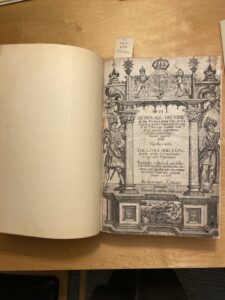
Fig. 1: Title page with Laurence Johnson’s engraving
The first thing one notices about The Generall Historie of the Turkes is its size. Standing a 12 in long by 8½ in wide by 3⅞ in tall and consisting of over 1152 pages, one cannot help but be drawn to it. This curiosity is rewarded when, turning over the cover, you are greeted by an intricate engraving that depicted the title flanked by a colonnade and two armored men (figure 1). The sheer length of the title, The Generall Historie of the Turkes, From the First Beginning of That Nation to the Rising of the Othoman Familie: with all the Notable Expeditions of the Christian Princes Against Them. Together With the Lives and Conquests of the Othoman Kings and Emperors Faithfullie Collected Out of the Best Histories, Both Ancient and Moderne, and Digested into One Continuat Historie Untill This Present Yeare 1603, demands further investigation.
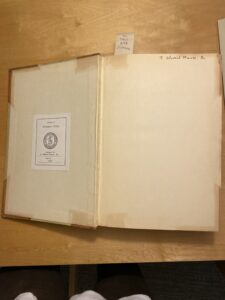
Fig. 2: Bookplate and Munce’s signature
Apart from its artistry of this page, engraved by Laurence Johnson, one can glean much information about the book’s biography. Richard Knolles authored it, and Adam Islip published the work in London 1603, making it a first edition (“Generall Historie of the Turkes First Edition – Richard Knolles”). T. Edward Munce Sr is written on the bookplate, informing the observer who donated the book to Dickinson, where it currently resides (figure 2). A friend named Francis Wayne MacVeagh apparently gave the book to Munce, evidenced by an inscription on the back of the title page, though where he got the book is not apparent. A last name is associated with the book, King James I of England, to whom a lengthy dedication is written just after the title page (figure 3). This regal audience explains the amount of money put into the work.
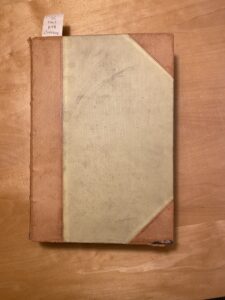
Fig. 4: The book cover, showing the worn leather binding
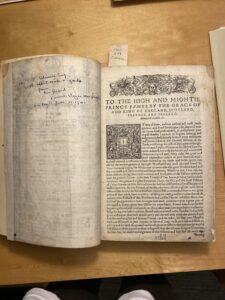
Fig. 3: Dedication to King James I
The Generall Historie of the Turkes’ physical condition has much to tell an observer about the book’s story. The binding, composed of half leather and half stiff fabric according to archivist Melinda Triller, is obviously not original but still is showing its age (figure 4). The leather is heavily worn along the joint making the front cover feel like it might detach from the book. It is also flaking-small, almost powdery bits are left on the desk after handling. The bottom right corner is torn, revealing the cardboard beneath. Despite this exterior wear, the book never feels at risk of falling apart in your hands. Acid from the leather, or perhaps the glue holding down the boards, has stained the end papers that got installed with the new binding, which is of a much sturdier stock of paper than the book itself (figure 2).
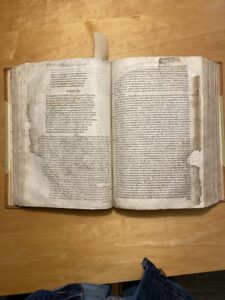
Fig. 5: An example of extremely worn pages with repairs
The original paper is of varying quality and state of repair. For the most part it has held up well; the paper is sturdy and thick. However, occasionally, the paper feels quite thin and flimsy, reminding you that the book is centuries old. The most glaring issues are the several pages that are far more worn, its edges frayed and stained (figure 5). These pages have had substantial repair work done to them, with the deteriorated page affixed to a backing of thin paper that has an almost tape-like texture to it. The backing brings the page back to its original proportions and stops more wear from page turning. Some pages in the front matter have been cropped, as evidenced by Laurence Johnson’s name being partially cut off (figure 1).
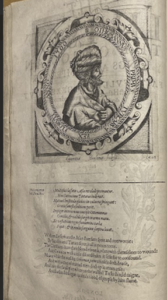
Fig. 7: Portrait with a poem
The book is full of other of Johnson’s engravings. He made detailed headpieces for the different sections of the history, along with initial letters for each chapter. Most impressive, I would say, are the black-and-white engravings of the Ottoman kings and emperors’ portraits present at the beginning of their respective biographies, as well as that of some of the other important figures such as Skanderbeg (figure 6). The beginning of each monarch’s biography also has a poem, written by Knolles or another poet, and written in both Latin and English about their reign (figure 7). Knolles also put aides for his Christian audience that list some contemporaneous rulers of Europe. These features make this book special and show off the care taken in its crafting.
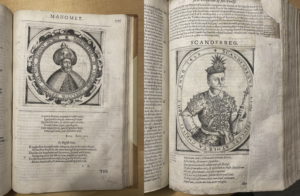
Fig. 6: Two example portraits
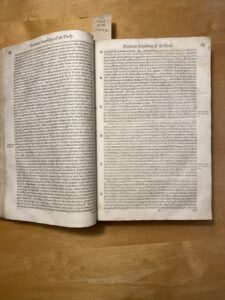
Fig. 8: A page with no paragraph breaks
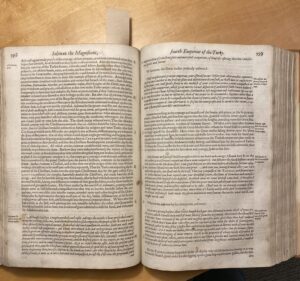
Fig. 9: Knolles’ use of quotations in the narrative
Reading the book is interesting as a modern person. Paragraph breaks are scarce, some pages having none (figure 8). Perhaps to aid with this, several letters are placed in the margins to break up the walls of text. The largest barrier to surmount, though, is the 17th century spelling. The infamous long s is easy enough to adapt to, but other quirks like how v and u seemingly being interchangeable slows reading down considerably. Trying to parse words such as ‘diuers’ (diverse) is particularly a challenging experience. The content of the book is more chronology that what we would call history, although Knolles tries to explain the Ottomans’ success in an afterword. His narrative style is accentuated by his inclusion of sometimes long quotations of speeches (figure 9). To aid the reader’s understanding of chronology, and to help find certain events, short blurbs are placed in the margins summarizing events.
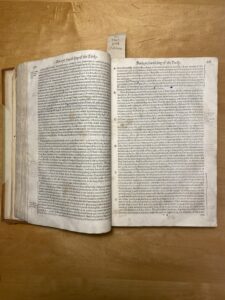
Fig. 10: Someone notated the book with blue ink
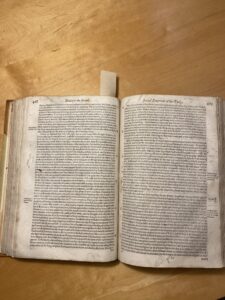
Fig. 11: Another person’s doodles
The last 421 years have left the book with many marks. There are, of course, the various stains one might expect from such an old book, from water or occasional ink. Along with these, though, are some quite intriguing finds. For a few pages starting with pg. 220, someone notated the text with blue ink, underlining certain passages (figure 10). Bayezid I’s conflict in with Tamerlane greatly interested this mystery annotator, it would seem. Another annotator made many doodles and marks around page 468 (figure 11). There is some damage, such as a tear on page 309 and interestingly a burn mark on page 248 (figure 12). The most humanizing, I think, is someone’s math on page 293 (figure 13). This equation to figure out how long ago an event took place really spoke to me, showing how I am connected through this physical artifact to someone from 1722.
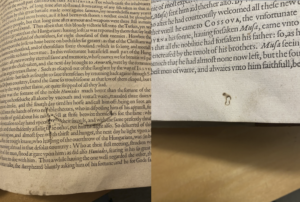
Fig. 12: The tear and burn
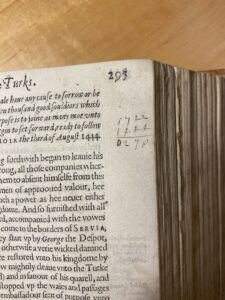
Fig.13: Someone’s math to figure out how long ago an event occurred
Works Cited
“Generall Historie of the Turkes First Edition – Richard Knolles.” Bauman Rare Books
Knolles, Richard. The Generall Historie of the Turkes. Adam Islip, 1603.
Leave a Reply